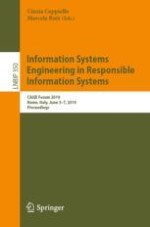This book constitutes the thoroughly refereed proceedings of the CAiSE Forum 2019 held in Rome, Italy, as part of the 31st International Conference on Advanced Information Systems Engineering, CAiSE 2019, in June 2019.
The CAiSE Forum - one of the traditional tracks of the CAiSE conference - aims to present emerging new topics and controversial positions, as well as demonstration of innovative systems, tools and applications related to information systems engineering. This year’s theme was “Responsible Information Systems”.
The 19 full papers and 3 short papers presented in this volume were carefully reviewed and selected from 14 direct submissions (of which 7 full papers were selected), plus 15 transfers from the CAiSE main conference (which resulted in another 12 full and 3 short papers).
